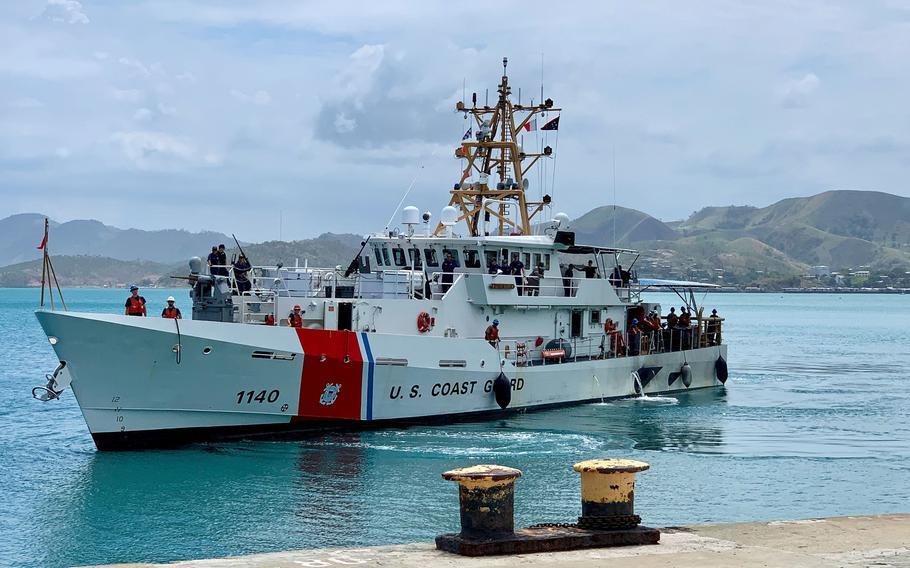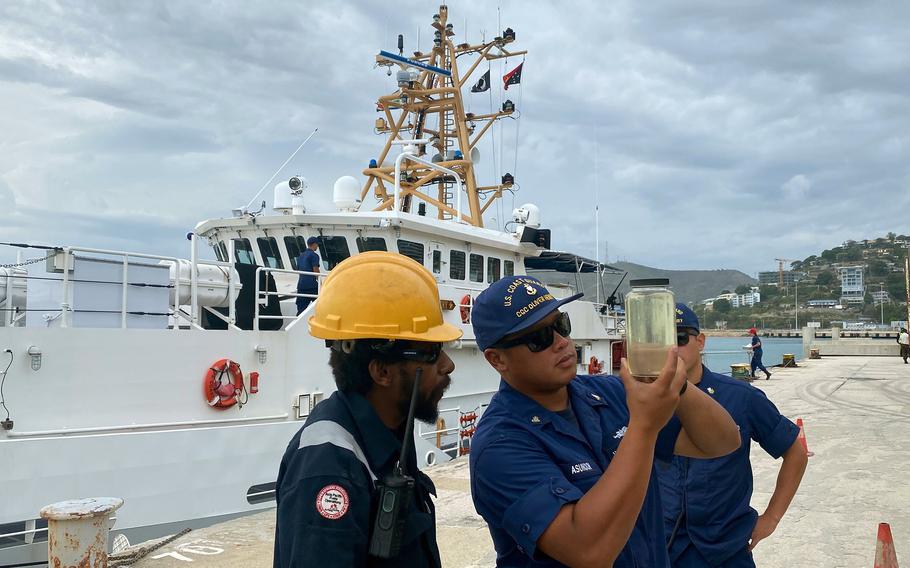
The Coast Guard fast response cutter Oliver Henry arrives in Port Moresby, Papua New Guinea, Aug. 23, 2022, following a patrol in parts of the Coral Sea and the Solomon Islands. (U.S. Coast Guard)
The Coast Guard’s fast response cutter Oliver Henry returned home to Guam this week after completing a 43-day expeditionary patrol across Oceania intended to usher in a greater presence in the region by the service.
The 8,000-nautical-mile mission took the cutter to Papua New Guinea, Australia, the Federated States of Micronesia and along the coast of the Solomon Islands before returning to Guam on Monday.
“What Oliver Henry did this past patrol was really trailblaze a path forward for continued presence in the region,” Lt. Freddy Hofschneider, Oliver Henry’s commander, said in a phone interview Wednesday from Guam.
The mission timing was ideal because many of the islands of Oceania — a vast geographical area that includes Australia, New Zealand, Melanesia, Micronesia and Polynesia — are only now allowing ship visits after restricting access during the first years of the coronavirus pandemic, Hofschneider said.
The 154-foot-long Sentinel-class fast response cutters are the newest generation of patrol boats entering the Coast Guard’s force. Nearly 50 of the cutters have been added to its fleet over the past 10 years.
Oliver Henry was one of three fast response cutters commissioned in Guam last summer. The trio that included Frederick Hatch and Myrtle Hazard replaced the Coast Guard’s pair of 110-foot patrol boats on the island, which were designed primarily for search-and-rescue missions close to home.

A machinery technician from the Coast Guard’s fast response cutter Oliver Henry conducts a fuel test after the boat’s arrival in Port Moresby, Papua New Guinea, Aug. 23, 2022. (U.S. Coast Guard)
The fast response cutters are capable of long-distance missions and can be used for drug interdiction, defense operations, maritime law enforcement and environmental protection. They are armed with four, .50-caliber machine guns and a remote-controlled, 25-mm cannon, can reach speeds up to 28 knots and can stay at sea for five days.
“The fact that we can take these 154-foot ships with a crew of 25 and a lieutenant commanding officer and push them so far over the horizon, even as far as Australia – which is what Oliver Henry just did – is an incredible capability for the region,” Capt. Nick Simmons, commander U.S. Coast Guard Forces Micronesia/Sector Guam, said in a news release Monday.
He commanded one of the 110-foot patrol boats while stationed in Guam from 2008 to 2010, which at the time were regarded as “a very capable platform for operating in Oceania,” Simmons said during a phone interview Wednesday. “At least we thought so 15 years ago.”
“We're pushing these fast response cutters 1,000, 1,200, 1,500 miles in one direction on a single tank of gas to provide presence, search-and-rescue capability, law enforcement, enacting bilateral shiprider agreements with our partners, boarding on the high seas,” he said.
Shiprider agreements allow law enforcement officers of a host nation to ride aboard Coast Guard vessels, an arrangement used for policing illegal fishing in a country’s exclusive economic zone.
In 2019, Adm. Karl Schultz, then the Coast Guard commandant, said that stationing three fast response cutters in Guam was a response to “coercive and antagonistic behavior from China.”
Beijing’s designs for Oceania became clearer in March when a leaked draft security agreement between China and the Solomon Islands seemed to authorize China to port warships and provide police assistance to the Solomons.
Both countries have denied that China will establish a military base there, but U.S. and Australian officials reacted with alarm over the prospect of China displacing their longtime leadership roles in the region.
In late August, the Oliver Henry was denied access for a scheduled port visit in the Solomon Islands. The boat instead docked at Port Moresby, Papua New Guinea, to take on needed fuel and provisions.
Simmons described the missed port call in the Solomons as a “processing issue” and that partnering with that nation “is certainly something on the table for us.”
Another certainty, Simmons said, is that Guam’s three fast response cutters “are not going to stay home and patrol just around Guam and [Northern Mariana Islands].
“They will regularly be stretching their legs all the way into the rest of our search-and-rescue region, our off area, which includes all the way down to the Equator and north toward Japan and onto the high sea,” Simmons said.